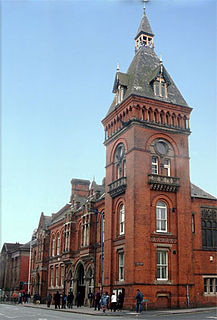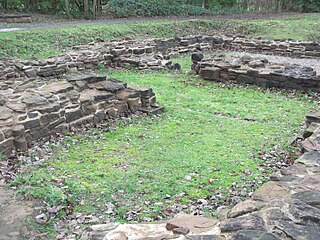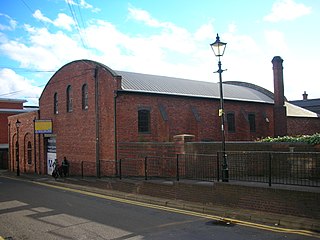
The Birmingham and Staffordshire Gas Light Company operated in Birmingham and Staffordshire from 1825 to 1875.

The Birmingham and Staffordshire Gas Light Company operated in Birmingham and Staffordshire from 1825 to 1875.
In 1825, the Birmingham and Staffordshire Gas Light Company was founded by act of parliament to manufacture and supply gas to Birmingham and a number of surrounding towns, including West Bromwich; [1] the lighting of the main road through the town was also mentioned in the Act. [2]
The Swan Village Gas Works were the first part of the complex to be constructed, and when completed in 1829 were the largest in the country. [3]
In 1874, the Mayor of Birmingham, Joseph Chamberlain, lead the Council to buy out the company. An Act of Parliament was obtained in July 1875 and the Birmingham Corporation Gas Committee was set up. [4]

The West Midlands sometimes referred to as the "West Midlands County" is a metropolitan county in the West Midlands Region, England with a 2020 estimated population of 2,939,927, making it the second most populous county in England after Greater London. It appeared as a metropolitan county in 1974 after the passage of the Local Government Act 1972, to cover parts of Staffordshire, Worcestershire and Warwickshire. The county is a NUTS 2 region within the wider NUTS 1 region of the same name. It embraces seven metropolitan boroughs: the cities of Birmingham, Coventry and Wolverhampton, and the boroughs of Dudley, Sandwell, Solihull and Walsall. The county is also a combined authority which is over seen by the West Midlands Combined Authority which covers all seven boroughs and other non-constituent councils on economy, transport and housing.

Staffordshire is a landlocked county in the West Midlands of England. It borders Cheshire to the northwest, Derbyshire and Leicestershire to the east, Warwickshire to the southeast, the West Midlands County and Worcestershire to the south, and Shropshire to the west.

The Black Country is an area of the West Midlands county, in the United Kingdom covering most of the Metropolitan Boroughs of Dudley, Sandwell, and some minor parts of Walsall. Dudley and Tipton are generally considered to be the centre. It became industrialised during its role as one of the birth places of the Industrial Revolution across the English Midlands with coal mines, coking, iron foundries, glass factories, brickworks and steel mills, producing a high level of air pollution.

Burton upon Trent, also known as Burton-on-Trent or simply Burton, is a market town in the borough of East Staffordshire in the county of Staffordshire, England, close to the border with Derbyshire. In 2011, it had a population of 72,299. The demonym for residents of the town is Burtonian. Burton is 11 miles (18 km) southwest of Derby, 27 miles (43 km) northwest of Leicester, 28 miles (45 km) west-southwest of Nottingham and 20 miles (32 km) south of the southern entrance to the Peak District National Park.

Walsall is a market town and administrative centre in the West Midlands County, England. Historically part of Staffordshire, it is located 9 miles (14 km) north-west of Birmingham, 7 miles (11 km) east of Wolverhampton and 9 miles (14 km) from Lichfield.

West Bromwich is a market town in the borough of Sandwell, West Midlands, England. Historically part of Staffordshire, it is 6.4 miles (10.3 km) north-west of Birmingham. West Bromwich is part of the area known as the Black Country, in terms of geography, culture and dialect. West Bromwich had a population of 77,997 in 2011 Census.

Smethwick is an industrial town in Sandwell, West Midlands, England, historically in Staffordshire. It lies four miles west of Birmingham city centre, and borders West Bromwich and Oldbury to the north and west. Formerly a Staffordshire county borough, Smethwick is situated near the edge of Sandwell metropolitan borough and borders the Birmingham districts of Handsworth, Winson Green, Harborne, Edgbaston and Quinton to the south and east, as well as the Black Country towns of West Bromwich and Oldbury in the north and west.

Wednesbury is a market town in Sandwell in the county of West Midlands, England. It is located near the source of the River Tame. Historically part of Staffordshire in the Hundred of Offlow, at the 2011 Census the town had a population of 37,817.

The West Midlands is one of nine official regions of England at the first level of International Territorial Level for statistical purposes. It covers the western half of the area traditionally known as the Midlands. The region consists of the counties of Herefordshire, Shropshire, Staffordshire, Warwickshire, West Midlands and Worcestershire. The region has seven cities Birmingham, Coventry, Hereford, Lichfield, Stoke-on-Trent, Wolverhampton and Worcester. The largest towns in the region with large population centres are Bromsgrove, Burton-upon-Trent, Cannock, Dudley, Great Malvern, Halesowen, Kidderminster, Leamington Spa, Nuneaton, Redditch, Rugby, Shrewsbury, Solihull, Stafford, Stourbridge, Sutton Coldfield, Tamworth, Telford, Walsall and West Bromwich.

This article is about the government of Birmingham, England.

South Staffordshire Water plc known as South Staffs Water is a UK water supply company owned by a privately owned utilities company serving parts of Staffordshire the West Midlands as well as small areas of surrounding counties in England. South Staffordshire Water plc is part of South Staffordshire plc. It purchased Cambridge Water in 2011. In 2013, KKR & Co. L.P., a company registered in the United States of America, acquired South Staffordshire Water from Alinda Infrastructure Fund. As of April 2018, KKR & Co. L.P., has agreed to sell its 75% equity stake in South Staffordshire plc to Arjun Infrastructure Partners (AIP). This deal will include South Staffs Water (SSW) and its non-regulated businesses, SSI Services and Echo Managed Services.

West Bromwich Town Hall is a municipal building in West Bromwich, West Midlands, England. It is a Grade II listed building.

Wood Green railway station was a railway station that opened on the Grand Junction Railway in 1837. It served the Wood Green area of Wednesbury and Walsall. It was located near to where junction 9 of the M6 motorway has been located since the late 1960s.

Swan Village Gas Works, is a historical manufacturing plant in the United Kingdom for the production of coal gas, or, as it was known in the vernacular, "town gas". The works are situated in Swan Village, a part of West Bromwich in the metropolitan borough of Sandwell. Most of the works have been demolished although a few relics survive. Parts of the works are still in operation today as part of the National Grid.

Sandwell Priory was a small medieval Benedictine monastery, near West Bromwich, then part of Staffordshire, England. It was founded in the late 12th century by a local landowner and was only modestly endowed. It had a fairly turbulent history and suffered considerably from mismanagement. It was dissolved in 1525 at the behest of Cardinal Wolsey – more than a decade before the main Dissolution of the Monasteries under Henry VIII

The administrative boundaries of Worcestershire, England have been fluid for over 150 years since the first major changes in 1844. There were many detached parts of Worcestershire in the surrounding counties, and conversely there were islands of other counties within Worcestershire. The 1844 Counties Act began the process of eliminating these, but the process was not completed until 1966, when Dudley was absorbed into Staffordshire.
The South Staffordshire and Birmingham District Steam Tramways Company which became the South Staffordshire Tramways Company operated a tramway service from their depot in Wednesbury between 1883 and 1924.
The Birmingham, Wolverhampton and Dudley Railway was an English railway company promoted to connect those places by rail. It was authorised by Parliament in 1846. It became apparent that it would be advantageous to merge with the Great Western Railway. The rival London and North Western Railway went to great lengths to frustrate the amalgamation, but ultimately failed, and the merger took place in 1847.

Perry Barr Urban District, or Urban District of Perry Barr was an area of England for local government administrative purposes. As such, it was administered locally by Perry Barr Urban District Council. It took its name from the included hamlet of Perry Barr, which was until then in the parish of Handsworth. It was created in 1894 as a result of the Local Government Act 1894, as a subdivision of the administrative county of Staffordshire, and existed until 1928, when it largely became part of Birmingham, and so also part of the county of Warwickshire. At that time, small parts of the district were granted to the Royal Town of Sutton Coldfield, also in Warwickshire, and to West Bromwich. In 1974, Birmingham was taken out of Warwickshire and became part of the West Midlands county, as was Sutton Coldfield, which became part of Birmingham at the same time.

The Birmingham Gas Light and Coke Company operated in Birmingham from 1819 to 1875.